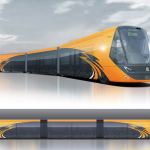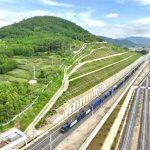Public transportation has larger implications than most people realize. These effects are across a spectrum of issues, from the world of finance to global warming. One estimate suggested that, “an investment of $10 million in public transportation generates about $32 million in increased business sales, and residential property values for homes located near public transit with high frequency service “performed 42% better on average.” Public transit also significantly reduces emissions per person compared to other forms of transportation. According to the source, “buses emit 20% less carbon monoxide, 10% as much hydrocarbons, and 75% as much nitrogen oxides per passenger mile than an automobile with a single occupant.” There are also a host of other benefits to public transportation including increased fuel efficiency, reduced traffic congestion, and safety. So, it is of interest to compare the public transportation systems of two of the world’s largest countries in terms of population and size: the United States and China. As we will see, China is ahead of the United States in just about every metric relating to public transportation, and it is helping them have an upper edge in terms of economic development.
Let’s start with the United States. In the United States, Americans take 10 billion trips on public transportation a year. The industry is estimated to be 80 billion dollars and employs half a million people. Public transportation systems in the United States are mostly focused on urban centers and their surrounding areas. Usually, these systems are comprised of buses and light rail. There are also intercity bus systems, mostly along the northeastern part of the United States, which are run by private companies but are often publicly subsidized. Long distance travel by public transportation is only possible by the national rail service, Amtrak. However, the vast majority of long distance travel is made up by air travel, which are operated by private, for-profit airlines.
The majority of travel in the United States is taken up by cars, with over 95% of American households owning one and 85% using it as their primary method of getting to work everyday. This is largely due to the policies relating to the suburban sprawl during the 1950s and 60s, where a large portion of the population moved away from urban cores and into the surrounding areas. Another reason is the fact that efforts were made to destroy public transport during this period to make way for sprawling highways. Furthermore, many local policy makers in the United States see public transportation as a form of welfare and are against the expansion of it for this reason. In fact, many cities in the U.S. have rejected proposals for expanded public transportation because residents are afraid of “undesirable” citizens coming into their neighborhoods. These motivations are oftentimes racial.
Meanwhile, the situation in China is quite different. China’s statistics relating to public transportation are quite astonishing. When looking at their transportation network, one must start with their rail network. Prior to the 1950s, there were only 13,546 miles (21,800 kilometers) of railway lines. In the modern day, China has expanded their rail network into the largest in the world reaching 86,371 miles (139,000 kilometers) of railway lines. Planes are not the primary mode of transportation for medium, long distance trips like they are in the United States; rather it is the railway. In addition to the sheer length of railway lines that China has managed to build over the past 50 years, they have also managed to electrify much of the network, making travel up to twice as fast as non-electrified train travel. This electrified rail network is the longest in the world, with 21,748 miles (35,000 kilometers) of high-speed lines. In total, more than 70% of China’s railway network is electrified compared to less than 2% of that in the United States. China is also home to the fastest train in the world, the Maglev (Magnetic Levitation), which can reach speeds of up to 270 miles per hour (430 miles per hour). For reference, the fastest train in America can reach speeds up to 165 miles per hour (266 kilometers per hour).
Then, there’s the local public transportation in China. Currently, China possesses the world’s longest, second and third longest metro systems. On top of that, of the top 15 longest metro systems in the world, 8 of them are in China, and they also possess half of the top ten busiest metro systems in the world. In terms of development, China is spending a lot more effort expanding their transportation networks than in the US. To be specific, China plans to spend 4.7 trillion yuan ($706 billion) on transport infrastructure in the next three to five years. So, how can China afford to invest so much in public transportation while the United States lags so far behind? After all, it is not as if China is magnitudes richer than the United States. The answer is because they have the political will to invest in public transit. The United States’s democratic political system is not conducive to the rapid development of high speed rail or other forms of public transport. Meanwhile, China’s communist party essentially controls all facets of the economy, so if they decide something is worth investing in, they will invest in it. In this case, China’s government has highly prioritized public transportation as a means of rapid economic development, and it’s working.
So, what does this all mean in terms of the grand scheme of economic development between the U.S. and China? In short, China’s investment in transportation is helping them gain an upper hand in every facet of economic development. China not only has great public transportation infrastructure but is also investing in it to make it faster, cheaper, and more accessible. Numerous studies have shown that increased transportation directly correlates to increased economic development. It is no coincidence that America is currently in the process of passing a multi-trillion dollar infrastructure bill that, if passed, will heavily invest in public transportation. As one source puts it perfectly, “China provides great success stories on how to develop and scale resilient transportation systems. The U.S. can take inspiration from the examples above, and mobilize American ingenuity to build our own resilient transportation systems for the 21st century.”


